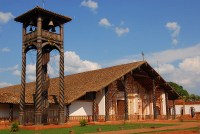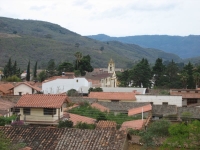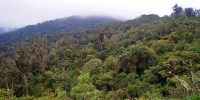Santa Cruz de la Sierra Travel Guide
Founded by Spanish conquistador, Nuflo de Chavez in 1561, Santa Cruz is Bolivia's largest city. In contrast with many of the country's cities, it lies a mere 1,365 feet (416m) above sea level and enjoys a tropical feel. Its conditions can be a welcome break from the harshness of the Bolivian Andes.
Many travellers visit Santa Cruz as a transit destination, given that planes have an easier time landing at Santa Cruz than navigating the mountains around La Paz. That said, Santa Cruz is a fascinating travel destination in its own right, and worth at least a day or two of exploration.
Strolling through town is a great way to take in the beautiful colonial architecture. Tourists can enjoy the many shops and restaurants, or join locals in the Plaza 24 de Septiembre, where people gather to play chess, feed the pigeons, or sip wine at outdoor cafes. Santa Cruz is also known as the fashion capital of Bolivia, and locally made clothing is a popular souvenir. The city's cosmopolitan ambience extends to discos, museums and art galleries.
Santa Cruz's comfort and convenience make it an ideal base from which to explore some of Bolivia's most popular attractions. These include Park Amboro, and the historical Jesuit missions. There are also daily flights to La Paz, and buses to many other destinations.
Things to do in Santa Cruz de la Sierra
Santa Cruz is Bolivia's most cosmopolitan city and, in many ways, the least representative of the country as a whole. Its low altitude and tropical climate only reinforce this distinction.
The city's population is diverse and its centre pulses with business. Perhaps as a consequence of its commercial energy, tourism in Santa Cruz is less about serious sightseeing, and more about shopping sprees, and enjoying the range of bars and restaurants.
Indeed, visitors won't find many iconic Bolivian landmarks or attractions. That said, Santa Cruz is a good base from which to venture into the wider region. Favourite day trips include trekking in Amboro National Park, visiting the nearby cultural hub of Samaipata, and exploring the many old Jesuit Missions in the area.

Jesuit Missions of the Chiquitos
The Jesuit Church sent missionaries to a number of Bolivia's rural areas in the 16th century, with instructions to 'civilise' and convert indigenous tribes. Today, travellers can visit the churches they built and cultivated. Many vibrant villages lie around these beautiful colonial structures, which were collectively designated a UNESCO World Heritage Site in 1990. The six historic missions that remain intact are San Miguel, San Jose, Santa Ana, Concepcion, San Rafael, and San Francisco Javier. All of them are in the Chiquitania region near Santa Cruz. Many local tour operators offer packages that include visits to several villages, all within easy reach of the city.

Samaipata
The tiny village of Samaipata lies two hours' drive southwest of Santa Cruz. Its home to an array of local tribes and some beautiful examples of Spanish colonial architecture. Visitors will encounter several important attractions, including El Fuerte, which is a set of pre-Incan ruins designated a UNESCO World Heritage Site, and the Las Cuevas Waterfalls. Condor Mountain and the stunning Amboro National Park are also nearby. Travellers should note that Samaipata is the start and end point of the Che Guevara Trail, which visits sites of interest.

Amboro National Park
Amboro National Park is a nature reserve in central Bolivia. Its wildlife population includes more than 800 species of birds, and many endangered animals such as the puma, jaguar and spectacled bear. Hikers will encounter a diverse terrain, which covers the northern Chaco, Andes foothills, and Amazon Basin. The region's spectacular scenery features canyons, forests, mountains, rivers, and waterfalls. Visitors can pass the time birdwatching at La Chonta outlook, sunning themselves on the beaches of the Surutu River, or hiking the Yungas Mountains. Getting to the park is relatively easy, given that it's only around 93 miles (150km) northwest of Santa Cruz de la Sierra. A number of tour operators offer outings to Amboro and a range of activities in the park.
Bolivia travel info
Electricity
220-230 volts, and 50-60Hz. US flat-bladed, two-pin plugs and two-pin plugs with round grounding are used.
Language
Though Spanish is an official language, only 60 to 70 percent of the people actually speak it, often as a second language. Many indigenous languages, such as Quechua and Aymara, are also official.
Money
The official currency is the Bolivian Boliviano (BOB), which is divided into 100 cents (centavos). Money can be exchanged at bureaux de change in the main centres, at banks and hotels - banks are generally considered the best places to exchange currency. Main centres accept USD, but travellers will need cash when they journey to more remote areas.
Banking facilities are good in the main cities and ATMs cater for Visa and MasterCard. Major credit cards such as MasterCard, Dinersclub, Visa, and American Express are accepted in shops, restaurants and the bigger hotels.
Tipping
A service charge is typically added to restaurant and hotel bills in Bolivia, but it is customary to add a five to 10 percent tip for good service over and above this charge. Porters at hotels expect small tips and drivers are only tipped if hired for a full day.
Health
Altitude sickness is the most common complaint in Bolivia, with much of the country lying above 10,000 feet (3,050m). Yellow fever vaccinations are advised as outbreaks do occur, particularly after flooding, and it's a requirement for those entering from infected areas. Malaria is prevalent in some parts of the country, as is dengue fever. It's best to only drink bottled water, and avoid undercooked meat and unpeeled fruit and vegetables. Comprehensive travel insurance is strongly recommended as medical facilities are generally not of a high standard.
Safety
Bolivia is generally a safe destination, though visitors should be vigilant at all times. Pick-pocketing takes place on buses and in crowded areas. Travellers should avoid unlicensed guides and stay away from political demonstrations. Floods and mudslides from heavy rainfall may also strongly affect transport.
Local customs
In conversation, rural Bolivians should be referred to as campesinos rather than Indians, as the later is seen as offensive. 'Machismo' is very much alive and husband and wife roles within the family are very traditional. Homosexuality is frowned upon, particularly in the Altiplano. Formal occasions call for a suit and tie for men, while women should wear dresses. It's also expected to call those older than you 'Señor' and 'Señora' as a polite sign of respect.
Doing business
Relationship building is important is Bolivia, so getting down to business might take some time. Foreigners should remember not to rush things. Negotiations are generally quite slow, and face-to-face communication is preferred over phone calls or written communications. For these reasons, foreigners should be prepared to make many trips before reaching an agreement. Punctuality is expected, even if the meeting doesn't start on time, and schedules are often just a guideline. Consequently, meetings are fairly unstructured and deadlines are often unimportant.
Business people are expected to wear suits. Meetings begin and end with handshakes, with custom demanding that men wait for women to extend a hand first. It's important to include a person's professional title in the greeting if applicable. Otherwise, it's polite to use Señor (Mr) or Señora (Mrs) with a surname. Business cards should also include any academic qualifications, and should have one side translated into Spanish.
Unfortunately, women are generally considered subordinate in the workplace and visiting businesswomen should emphasise their qualifications and work experience. Office hours are generally 8:30am to 6:30pm, Monday to Friday, with a long break over lunch.
Duty free
Travellers to Bolivia over the age of 18 years can bring the following items into the country without incurring customs duty: 400 cigarettes, 50 cigars, and 500 grams of tobacco, 3 litres of alcohol and a reasonable amount of perfume for personal use.
Newly purchased goods to the value of $1,000 per person are also duty free. Travellers departing from the country should note that it is illegal to leave with the following items without prior written permission from the appropriate local authority: pre-Colombian artefacts, historical paintings, items of Spanish colonial architecture and history, and native textiles.
Communications
The international access code for Bolivia is +591. Mobile phones operate on a GSM network, with providers including Entel Movil, Tigo and Viva, while internet usage by the general population is on rise.
Passport & Visa
All visitors travelling by air should have return tickets and all required documents for their next destination, as well as sufficient funds to see them through their stay. All travellers arriving from yellow fever risk areas must show valid yellow fever vaccination certificates on entry to Bolivia. Those who qualify for visas on arrival need to carry all the required documentation translated into Spanish and should confirm these requirements in advance. Travellers who do not have the required fee, documents and photographs for a visa to be issued will be denied entry.
Entry requirements
US nationals must have a valid passport and a visa to enter Bolivia. A visa is obtainable on arrival for a fee payable in cash only, with an invitation letter Bolivian Immigration Authorities (DIGEMIG), a printed hotel reservation, a printed return/onward ticket, and a printed itinerary. The visa is valid for a stay of no more than 30 days.
UK nationals holding valid passports do not need a visa for stays of up to 90 days.
Canadians require a valid passport, but a visa is not necessary for touristic stays of up to 90 days.
Australians need a valid passport, but do not require a visa for touristic stays of up to 90 days.
South Africans require a valid passport on arrival and a visa to enter Bolivia. Visas can be issued on arrival for a fee in cash only, with an invitation letter Bolivian Immigration Authorities (DIGEMIG), a printed hotel reservation, a printed return/onward ticket, and a printed itinerary. Visas can also be obtained at http://www.rree.gob.bo/formvisas/. The visa is valid for a stay of no more than 90 days.
Irish nationals need a valid passport, but do not require a visa for touristic stays of up to 90 days.
New Zealanders need a valid passport, but do not require a visa for a touristic stay of up to 90 days.
Useful contacts
Ministry of Culture and Tourism, La Paz: +591 2 2200910 or www.minculturas.gob.bo/
Bolivian emergency numbers are 120 (police), 165 (ambulance) and 119 (fire department).


